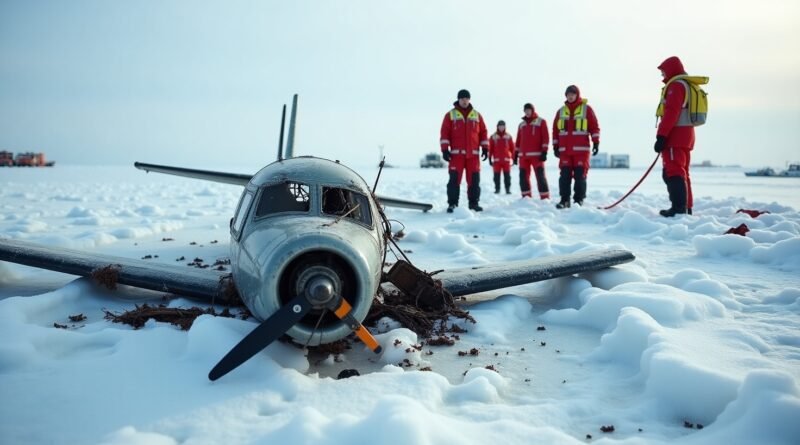Alaska Plane Crash: 10 Shocking Facts Behind the 2025 Air Disaster
🛫 Introduction: Alaska’s Aviation Lifeline—and Its Risks
The term Alaska plane crash evokes a chilling reality. Alaska is known for its rugged landscapes, icy waters, and remote villages. But for many who live there, flying isn’t a luxury—it’s a necessity. With limited roadways and vast distances, bush planes are vital for delivering food, supplies, and even medical care.
Yet this reliance on small aircraft comes with high risks. The recent crash of Bering Air Flight 445 in February 2025, killing all 10 people on board, was a stark reminder of how deadly Alaskan skies can be.
This article dives deep into the Alaska plane crash, its historical context, NTSB findings, past tragedies, and the need for urgent reform. It’s SEO-optimized and designed to perform well on both Google and mobile platforms.

✈️ Bering Air Flight 445: A Devastating Alaska Plane Crash
🧭 The Flight Path
- Airline: Bering Air
- Aircraft: Cessna 208B Grand Caravan EX
- Route: Unalakleet → Nome, Alaska
- Date: February 6, 2025
- People on Board: 1 pilot, 9 passengers
- Fatalities: All 10 confirmed dead
Shortly after takeoff, radar contact was lost over Norton Sound. A day later, search and rescue teams located the wreckage lodged in the icy waters. This Alaska plane crash left debris scattered across the sea ice, highlighting how quickly routine flights can turn into tragedy.
🕵️ NTSB Investigation: What Caused the Crash?
📋 Key Findings
- Overloaded Aircraft: 1,058 lbs over weight limit
- Weather Conditions: Light snow, potential icing
- Pilot Fatigue: 58+ flight hours logged in the prior month
- Cargo Errors: Undocumented extra weight
- No Mechanical Fault: No technical failure found
According to the National Transportation Safety Board, the Alaska plane crash likely resulted from a combination of icing and dangerous overloading. These conditions caused the aircraft to stall, crashing into the ice-covered sea.
🧑⚕️ Victims and Public Reaction
This Alaska plane crash claimed the lives of healthcare professionals, Native elders, and residents relying on bush flights for essential services. Vigils were held in Unalakleet and Nome, as communities mourned those lost in the preventable tragedy.
📜 Historical Alaska Plane Crashes: A Pattern of Risk
Alaska consistently ranks among the top U.S. states for aviation fatalities. This wasn’t the first Alaska plane crash to make headlines.
🔁 Notable Historical Crashes
- Wien Air Alaska Flight 99 (1975) – Crashed near Gambell
- Ketchikan Mid-Air Collision (2019) – Sightseeing planes collided
- 2023 Moose Meat Crash – Involving Rep. Mary Peltola’s husband
- C-54 Fuel Crash (2024) – Aircraft exploded during refueling
Common themes include overloading, poor weather, and inconsistent enforcement of safety standards.
🦌 The 2023 Moose Meat Crash: A Striking Similarity
Eugene “Buzzy” Peltola Jr., husband of Rep. Mary Peltola, died in a small Alaska plane crash in 2023. The aircraft was overweight with moose meat and antlers. Investigators noted 117 extra pounds, plus unapproved external cargo.
Like Bering Air Flight 445, this tragedy points to systemic issues in bush aviation across the state.
📊 Comparing the Two Crashes
| Key Details | Bering Air 2025 | Peltola Moose Crash 2023 |
|---|---|---|
| Aircraft Type | Cessna 208B Grand Caravan EX | Piper Super Cub |
| Cause | Overweight + Icing | Overweight + External Drag |
| Fatalities | 10 | 1 |
| Location | Over Norton Sound | Near St. Mary’s, Alaska |
| Pilot Status | Commercial Pilot | Private Pilot |
| FAA Compliance | Flawed cargo manifest | No FAA approval for cargo |

🌨️ Aviation Challenges Unique to Alaska
❄️ Harsh Weather
Trace icing can be fatal, especially in overloaded planes.
🏔️ Tough Terrain
Mountains, tundra, and frozen coastlines offer few emergency options.
🛩️ Aircraft Dependency
Over 80% of Alaskan towns rely on planes for essentials, increasing exposure to aviation dangers.
✅ What Can Be Done? Safer Skies After Alaska Plane Crashes
📦 Cargo Weight Enforcement
Proper weighing and documentation must become mandatory.
🧑✈️ Pilot Monitoring
Rest periods should be enforced, and excessive flight hours discouraged.
❄️ Deicing Protocols
Require both ground and onboard deicing system checks before every cold-weather flight.
🛰️ Advanced Tracking
Satellite tracking and emergency beacons should be mandatory for bush flights.
🏘️ Local Training
Teach community leaders and hunters how to safely load aircraft for charter flights.
⚖️ Public Response and Legal Action
After the 2023 Alaska plane crash, Rep. Mary Peltola filed a wrongful death lawsuit. In 2025, families of Bering Air victims called for a federal overhaul of aviation enforcement in Alaska.
✍️ National Attention and Federal Response
In the aftermath of this Alaska plane crash, national media outlets began highlighting the systemic issues plaguing aviation safety in remote regions. Lawmakers in Washington, D.C. were urged by Alaskan representatives to investigate the FAA’s oversight in bush operations. The high fatality rate and the repetitive nature of these incidents caught the attention of transportation watchdogs and public safety advocates across the country.
📢 Growing Pressure for Policy Reform
Families of crash victims and aviation safety groups are now pushing for congressional hearings. They argue that most Alaska plane crashes could be prevented with better funding, stricter regulation, and modernized equipment. This public pressure is prompting the FAA and the National Transportation Safety Board to reevaluate inspection cycles, deicing policies, and cargo verification methods—especially for flights operating in isolated areas.
🛡️ The Role of Community Voices in Change
Rural Alaskan communities, often underserved and underrepresented, are beginning to demand transparency and safety reforms. From tribal councils to local pilots, there is a growing movement advocating for smarter infrastructure and better flight training programs. In a state where over half of small aircraft operate under Part 135 or private charters, public awareness is proving to be a crucial tool in reshaping aviation safety after every major Alaska plane crash.
✈️ Conclusion: Alaska Plane Crash Crisis and the Path Forward
Flying is essential in Alaska—but the risks are real. The Alaska plane crash involving Bering Air Flight 445, along with past incidents, show that stronger regulations and cultural shifts are needed to protect lives.
If these issues go unaddressed, Alaska will continue to face a haunting cycle of air disasters. Safety must be more than an option—it must be the standard.
📰 Related Articles You’ll Want to Read
🇨🇱 The Texas Flag True Meaning Will Surprise You
Discover the powerful symbolism behind the Texas flag — from its origins during the struggle for independence to the hidden meaning behind its bold colors and lone star. You’ll never look at it the same way again.
👗 Why the Blue Dress Never Goes Out of Style: History, Symbolism & Fashion Secrets
From royal courts to Hollywood runways, the blue dress has captured hearts across centuries. Dive into its timeless appeal, cultural roots, and how it became a symbol of confidence and elegance.

